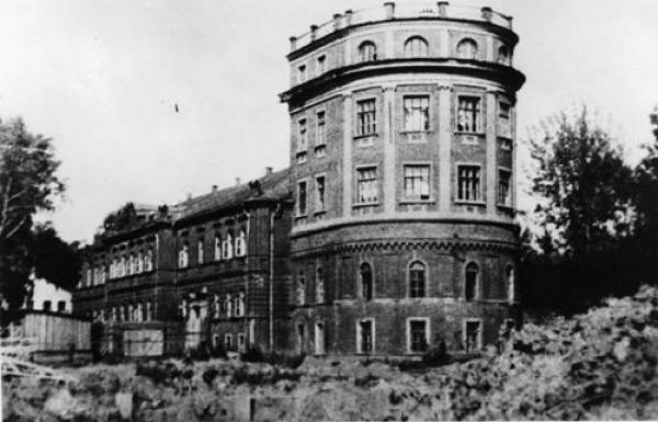
The place where the holding company Concern Avtomatika is located today has been known since 1884, when the Alexander-Mariinsky Shelter was built in the village of Marfino, which was awarded by the Tsar in 1623 to Dmitry Pozharsky and taken to the treasury on the orders of Catherine the Great for the children of rural priests. There, they were taught crafts and trained as religious leaders. The red brick building consisted of the seminary shelter itself and the hexagonal temple attached to it.
- In 1921 by Decree of the Council of People’s Commissars of the USSR, a special service was created to solve general issues of organizing secret communications in the country, developing state codes, recommendations for their use and exercising control over their correct application.
- In 1923, a shelter for the homeless was organized in the former seminary building in Marfino.
- In 1930 under the guidance of a young engineer V. A. Kotelnikov, a small group of communication developers created new equipment that ensured the secretion of telegraph and telephone transmissions on the short-wave communication line. This date is considered to be the starting point in the development of secret telephone communications.
- In 1947, Marfino opened a special prison No. 16.
- In 1948, in accordance with the decision of the Council of Ministers of the USSR, special laboratory No. 8 was organized in Marfino to develop secret equipment for high-frequency communications. The creators of systems for domestic classified communications, cryptographic technology and cryptography worked there, including academicians V. A. Kotelnikov, A. L. Mints, as well as many other prominent scientists and experts of the post-war period.
- In 1952, State Research Institute No. 2 was created on the basis of the laboratory, which was then later transformed into the enterprise of PO Box 37. Its main goal was to carry out vital research on the development and production of equipment for secret communications.
- In 1954, the first classified equipment was created. It was installed on the longest communication lines at that time: Moscow-Berlin, Moscow-Beijing.
- In 1955, PO Box 37 was renamed the Scientific Research Institute of Automation (NIIA).
- In 1960, the NIIA created the first generation of domestic cryptographic equipment: M-803-5, Liana, Almaz, Bulava, Korall, Elbrus, Yakhta, Laguna, and Delfin. The developers of this equipment were: A. P. Peterson, K. F. Kalachev, I. S. Neyman, A. M. Nanos, N. B. Petrov, Yu. Ya. Voloshenko, N. N. Naydenov, Yu. A. Soldatikhin, A. M. Vasilyev, A. N. Kabatov, B. A. Nikolayev, G. V. Kukushkin, A. F. Nosov, V. A. Nikitin, V. P. Dementyev and others.
- In 1978, NIIA was awarded the Order of Lenin for outstanding achievements in science and technology. Throughout the 1980s, special complexes of classified communications for technical equipment were created there.
- In 1994, the NIIA was identified as the head structural unit of the Russian State Scientific and Production Association (RGNPO) Avtomatika. NIIA was entrusted with the functions of managing a scientific and production association, and RGNPO Avtomatika became the managing organization.
- In 1994, special complexes of technical means of classified communications and control were created on the basis of microcircuits of small and medium degree of integration: Kavkaz, Rosa, Interyer. Along with the traditional direction of secure telephonics, a new class of devices for protecting digital and telecode information was created: Strekoza, Lan, Gazel, Grim, Alibek, Veter, Shtil, Shtorm, Shkval, Dub, etc.
- In 1995, Sergei Bukashkin, the first deputy general director of RGNPO Avtomatika, doctor of technical sciences, professor, academician of the Academy of Cryptography of the Russian Federation, and academician of the Moscow Aviation Institute, made a report during Section 6 (Radio Electronics) of the Scientific and Technical Council of Goskomoboronprom regarding the topic: “On the State and Prospects of Information technology security Development”. The Scientific and Technical Council made the decision to consider the correct and non-alternative direction of work in RGNPO Avtomatika to create advanced information security technology.
- In 1998, the institute was converted into State Unitary Enterprise Scientific Research Institute of Automation. The E-16 and Gamma devices underwent state testing.
- In 2001, the latest version of the charter of the Federal State Unitary Enterprise Scientific Research Institute of Automation (FSUE NIIA) was approved. Technical methods for special communications implementing qualitatively new principles and technologies for the creation of cryptographic devices were developed in FSUE. The equipment was intended for commercial sales as well as for sales to foreign customers.
- In 2006, the modernization of a small-sized device for automatic voice encryption, facsimile and documentary information in a mobile radio communication network in duplex mode, was transmitted at a speed of 2.4 / 4.8 / 9.6 Kbit/s via VHF and HF channels of the E-16 device, providing a counter-operation with the Epsilon apparatus.
- Up until 2008, a family of technical methods for special communications implementing qualitatively new principles and technologies for the creation of cryptographic devices were developed. A family of cryptographic equipment was developed for foreign and commercial sales.
- In 2010, Federal State Unitary Enterprise NIIA by the Decree of the President of the Russian Federation, was converted into Concern Avtomatika Open Joint-Stock Company.
- In 2014, on the basis of the Decree of the President of the Russian Federation and the Resolution of the Government of the Russian Federation, Concern Avtomatika became a part of Rostec State Corporation.
- In 2015, in accordance with the legislation of the Russian Federation, the name of the enterprise OJSC Concern Avtomatika was changed to JSC Concern Avtomatika.
- In 2017, the Holding’s development strategy until 2025 was adopted. The concern continued to further develop market competitive products, services and technologies that provide technological excellence.
- In 2018, Vladimir Alekseyevich Kabanov was appointed General Director of JSC Concern Avtomatika. Under his leadership, the Holding has worked to increase the level of diversification of its activities, and has continued to increase the volume of innovative products for military, dual and civilian purposes.

